|
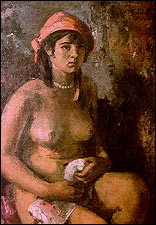 Among the Serbian painters of the 19th century it is important to mention Arsenije Arsa Teodorovic, the author of the well known portrait of Dositej Obradovic, and Pavel Djurkovic, the author of the first portrait of Vuk Karadjic from 1816. Among the Serbian painters of the 19th century it is important to mention Arsenije Arsa Teodorovic, the author of the well known portrait of Dositej Obradovic, and Pavel Djurkovic, the author of the first portrait of Vuk Karadjic from 1816.
For the later decades between 1830 and 1860 one could say that they represent the renaissance of Bydermayer and Nazarene painting. Academic painters Jovan Isailovic the younger, Dimitrije Jovanovic and Pavle Simic have left heritage in the sacral painting based on the school of Vienna Nazarenes. On the other hand, Konstantin Danil, Nikola Aleksic and Jovan Popovic influence the forming of the style of the citizens based on the ideas from Bydermayer painting. The honored place of the first lady painter in Serbia belongs 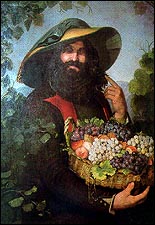 to Catarina Ivanovic who stayed in Belgrade for short time, while she was attached to Stoni Beograd (Sekesfehervar, Hungary) by life and work. to Catarina Ivanovic who stayed in Belgrade for short time, while she was attached to Stoni Beograd (Sekesfehervar, Hungary) by life and work.
The renaissance in the Serbian Principality starts in the fifth decade of the 19th century with the ideas of Dositej Obradovic and Vuk Karadjic. The rise of education and the establishment of the School of the Association of the Serbian Slovene Consciousness, Peoples Library and The Museum have supported Belgrade in becoming the capital of cultural life of the Serbian people.
The romantic style appears with the rebel painter and poet Djuro Jaksic, Stevan Todorovic, who started the first musical and sports activities, and Novak Radonic.
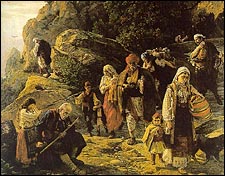 The realistic style in painting depended on the place of development or education of the artist and thus two directions existed : Kurbean composed of the works of Milos Tenkovic, Djordje Milovanovic and Djordje Krstic, as well as a direction defined by Vienna school popularized by famous Uros Predic and Paja Jovanovic. The expressionism of Nadezda Petrovic and impressionism of Malisa Glisic, Kosta Milicic, Milan Milovanovic and Borivoje Stevanovic represent the first decades of the fine arts in the 20th century. The appearance of this generation of fine art masters made it clear that Serbian culture and art turn towards Paris, as the new art metropolis. The protagonists of such art style were all directly attached to France. They were Jovan Bjelic, Sava Sumanovic, Ivan Radovic, Petar Dobrovic, Stojan Aralica, Veljko Stanojevic, Dusan Jankovic, Mile Milunovic, Marko Celebonovic, Mihail S. Petrovic, Petar Lubarda, The realistic style in painting depended on the place of development or education of the artist and thus two directions existed : Kurbean composed of the works of Milos Tenkovic, Djordje Milovanovic and Djordje Krstic, as well as a direction defined by Vienna school popularized by famous Uros Predic and Paja Jovanovic. The expressionism of Nadezda Petrovic and impressionism of Malisa Glisic, Kosta Milicic, Milan Milovanovic and Borivoje Stevanovic represent the first decades of the fine arts in the 20th century. The appearance of this generation of fine art masters made it clear that Serbian culture and art turn towards Paris, as the new art metropolis. The protagonists of such art style were all directly attached to France. They were Jovan Bjelic, Sava Sumanovic, Ivan Radovic, Petar Dobrovic, Stojan Aralica, Veljko Stanojevic, Dusan Jankovic, Mile Milunovic, Marko Celebonovic, Mihail S. Petrovic, Petar Lubarda, 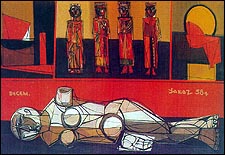 Zora Petrovic. The 30s were a time when color dominated over form. Among the expressionist colorists are Bjelic, Aralica, Ignjat Job I Milan Konjovic. Among those using picturesque values of self in time based on the art solutions of the French painters were Bonar and Pisaro there are Ivan Tabacovic, Celebonovic, Gvozdenovic, Baruh, Ljubica Sokic. At the same time there are works of surrealist painters such as: Milena Pavlovic Barili, Radojica Zivanovic, or socially engaged painters like: Djordje Andrejevic Kun and Zora Petrovic. The 30s were a time when color dominated over form. Among the expressionist colorists are Bjelic, Aralica, Ignjat Job I Milan Konjovic. Among those using picturesque values of self in time based on the art solutions of the French painters were Bonar and Pisaro there are Ivan Tabacovic, Celebonovic, Gvozdenovic, Baruh, Ljubica Sokic. At the same time there are works of surrealist painters such as: Milena Pavlovic Barili, Radojica Zivanovic, or socially engaged painters like: Djordje Andrejevic Kun and 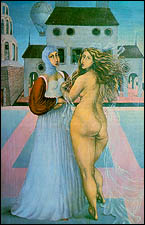 Vinko Gurdan or those who desired to combine expressiveness with the picturesque such as: Lubarda, Milosavljevic, Graovac and Serban. Vinko Gurdan or those who desired to combine expressiveness with the picturesque such as: Lubarda, Milosavljevic, Graovac and Serban.
After the second world war the development of the art schools and high schools already forming Universities was a support to the fine arts creativity in Serbia. Before all many types of abstraction appear, starting from the associative to expressionistic art (Bajic, Petrovic, Filipovic),but at the same time there are desires of some to express the link with the sight and tradition (Vozarevic, Vujaklija, Mica Popovic, Tomasevic). A group of medials and their spiritual mates Milan Popovic, Igor Vasiljev, Ljuba Popovic, Miodrag Djuric, Velickovic, Vidak, Sejka, Bradic, Ivanjicki, Vukovic, Milic Stankovic) use the 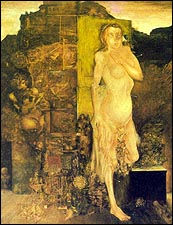 surrealist elements. In the Serbian painting of the 60 ties of this century the ideas of Enformel were specially accepted (Protic, Pavlovic, Turinski, Todorovic, Popovic, Bozickovic). By the end of 60s the painters accept numerous new ideas starting from pop art to hyperrealism (Blanusa, Otasevic, Cvetkovic, Damjanovski, Kalajic). The originality and the quality of the 70s is shown by the appearance of the artists who tried to combine the elements of realism with the ideas of conceptualism (Mojovic, Cvetkovic, Iljoski, Vasic, Damjanovski). The art of the 8os accepts and follows the variations of the poetics of the new picture of the new expressionism, new historicism, trans- or post-avantguard. surrealist elements. In the Serbian painting of the 60 ties of this century the ideas of Enformel were specially accepted (Protic, Pavlovic, Turinski, Todorovic, Popovic, Bozickovic). By the end of 60s the painters accept numerous new ideas starting from pop art to hyperrealism (Blanusa, Otasevic, Cvetkovic, Damjanovski, Kalajic). The originality and the quality of the 70s is shown by the appearance of the artists who tried to combine the elements of realism with the ideas of conceptualism (Mojovic, Cvetkovic, Iljoski, Vasic, Damjanovski). The art of the 8os accepts and follows the variations of the poetics of the new picture of the new expressionism, new historicism, trans- or post-avantguard.
|

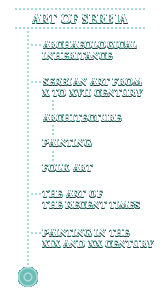



 Among the Serbian painters of the 19th century it is important to mention Arsenije Arsa Teodorovic, the author of the well known portrait of Dositej Obradovic, and Pavel Djurkovic, the author of the first portrait of Vuk Karadjic from 1816.
Among the Serbian painters of the 19th century it is important to mention Arsenije Arsa Teodorovic, the author of the well known portrait of Dositej Obradovic, and Pavel Djurkovic, the author of the first portrait of Vuk Karadjic from 1816.
 to Catarina Ivanovic who stayed in Belgrade for short time, while she was attached to Stoni Beograd (Sekesfehervar, Hungary) by life and work.
to Catarina Ivanovic who stayed in Belgrade for short time, while she was attached to Stoni Beograd (Sekesfehervar, Hungary) by life and work.
 The realistic style in painting depended on the place of development or education of the artist and thus two directions existed : Kurbean composed of the works of Milos Tenkovic, Djordje Milovanovic and Djordje Krstic, as well as a direction defined by Vienna school popularized by famous Uros Predic and Paja Jovanovic. The expressionism of Nadezda Petrovic and impressionism of Malisa Glisic, Kosta Milicic, Milan Milovanovic and Borivoje Stevanovic represent the first decades of the fine arts in the 20th century. The appearance of this generation of fine art masters made it clear that Serbian culture and art turn towards Paris, as the new art metropolis. The protagonists of such art style were all directly attached to France. They were Jovan Bjelic, Sava Sumanovic, Ivan Radovic, Petar Dobrovic, Stojan Aralica, Veljko Stanojevic, Dusan Jankovic, Mile Milunovic, Marko Celebonovic, Mihail S. Petrovic, Petar Lubarda,
The realistic style in painting depended on the place of development or education of the artist and thus two directions existed : Kurbean composed of the works of Milos Tenkovic, Djordje Milovanovic and Djordje Krstic, as well as a direction defined by Vienna school popularized by famous Uros Predic and Paja Jovanovic. The expressionism of Nadezda Petrovic and impressionism of Malisa Glisic, Kosta Milicic, Milan Milovanovic and Borivoje Stevanovic represent the first decades of the fine arts in the 20th century. The appearance of this generation of fine art masters made it clear that Serbian culture and art turn towards Paris, as the new art metropolis. The protagonists of such art style were all directly attached to France. They were Jovan Bjelic, Sava Sumanovic, Ivan Radovic, Petar Dobrovic, Stojan Aralica, Veljko Stanojevic, Dusan Jankovic, Mile Milunovic, Marko Celebonovic, Mihail S. Petrovic, Petar Lubarda,  Zora Petrovic. The 30s were a time when color dominated over form. Among the expressionist colorists are Bjelic, Aralica, Ignjat Job I Milan Konjovic. Among those using picturesque values of self in time based on the art solutions of the French painters were Bonar and Pisaro there are Ivan Tabacovic, Celebonovic, Gvozdenovic, Baruh, Ljubica Sokic. At the same time there are works of surrealist painters such as: Milena Pavlovic Barili, Radojica Zivanovic, or socially engaged painters like: Djordje Andrejevic Kun and
Zora Petrovic. The 30s were a time when color dominated over form. Among the expressionist colorists are Bjelic, Aralica, Ignjat Job I Milan Konjovic. Among those using picturesque values of self in time based on the art solutions of the French painters were Bonar and Pisaro there are Ivan Tabacovic, Celebonovic, Gvozdenovic, Baruh, Ljubica Sokic. At the same time there are works of surrealist painters such as: Milena Pavlovic Barili, Radojica Zivanovic, or socially engaged painters like: Djordje Andrejevic Kun and  Vinko Gurdan or those who desired to combine expressiveness with the picturesque such as: Lubarda, Milosavljevic, Graovac and Serban.
Vinko Gurdan or those who desired to combine expressiveness with the picturesque such as: Lubarda, Milosavljevic, Graovac and Serban.
 surrealist elements. In the Serbian painting of the 60 ties of this century the ideas of Enformel were specially accepted (Protic, Pavlovic, Turinski, Todorovic, Popovic, Bozickovic). By the end of 60s the painters accept numerous new ideas starting from pop art to hyperrealism (Blanusa, Otasevic, Cvetkovic, Damjanovski, Kalajic). The originality and the quality of the 70s is shown by the appearance of the artists who tried to combine the elements of realism with the ideas of conceptualism (Mojovic, Cvetkovic, Iljoski, Vasic, Damjanovski). The art of the 8os accepts and follows the variations of the poetics of the new picture of the new expressionism, new historicism, trans- or post-avantguard.
surrealist elements. In the Serbian painting of the 60 ties of this century the ideas of Enformel were specially accepted (Protic, Pavlovic, Turinski, Todorovic, Popovic, Bozickovic). By the end of 60s the painters accept numerous new ideas starting from pop art to hyperrealism (Blanusa, Otasevic, Cvetkovic, Damjanovski, Kalajic). The originality and the quality of the 70s is shown by the appearance of the artists who tried to combine the elements of realism with the ideas of conceptualism (Mojovic, Cvetkovic, Iljoski, Vasic, Damjanovski). The art of the 8os accepts and follows the variations of the poetics of the new picture of the new expressionism, new historicism, trans- or post-avantguard.